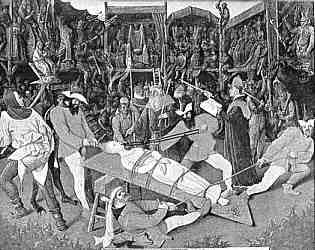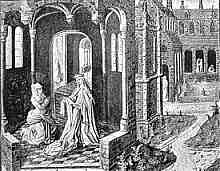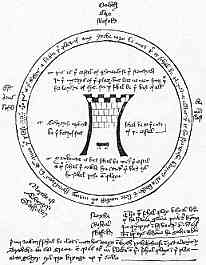 |
|
Drama
(4) |
|
Forms
of drama other than the grand Mystery
Play might be performed with smaller casts and less elaboration, and
to a different timetable. Miracle plays had their heyday in 14th century
France. A surviving manuscript of Miracles de Nostre
Dame depicts 14 apparently unrelated scenarios in which a miraculous
transformation occurs as a result of the appearance of a vision of the
Virgin Mary at a significant juncture. These were performed at one of
the festivals celebrating the Virgin. Scenes of everyday life were depicted
in these plays. |
|
| Manuscript
illumination of The Miracle of the Nun who left her
Abbey (Bibliothèque Nationale, MS franc 9199). She came back,
of course. |
|
Saints'
plays were associated with local festivals, and played on the occasion
of the feast of a patron saint of a parish church or guild. The earliest
version was the Latin liturgical
drama of St Nicholas, which was known from the 12th century. Later versions
may have ranged from simple tableaux to fully scripted plays. They were
most prolific in Italy and Spain, and could include the non-Biblical
saints which crept into the medieval calendar.
Scenes of violence, as in martyrdoms, could be quite gruesome. The saints'
plays were suppressed in the 16th century, for obvious reasons in Protestant
countries, but Catholic reformers also felt they overstepped the boundaries
of correctness and had elements of idolatry. |
 |
The
martyrdom of St Apollonia, as depicted in the Hours of Etienne Chevalier,
a book which has disappeared but the miniatures survive as framed art works.
(Yes, it would be nice to have a good reproduction of
this picture!) |
|
The
above example shows the unfortunate martyr losing her teeth in the foreground,
but the background detail shows that it actually depicts the performance of
a play. The audience is assembled in stands. One upper tier contains musicians.
Two angels sit on top of a ladder on the left and a devil occupies a platform
at the right. In the middle right is an authoritative figure wearing a bishop's
mitre and holding a book and long pointer. He is the prompter, but his role
is more active than in a modern play, acting essentially as a conductor. The
mitre may suggest some element of parody, and one does wonder on the significance
of a figure in the left foreground, apparently wearing transparent underpants
and scratching his buttocks. Religion may have suffused everything in the
middle ages, but they were less prim about it than we are today. |
|
Morality
Plays were essentially didactic, but were nevertheless presented in entertaining
mode. They were not tied to the church calendar, and surviving examples are
relatively short, so they could be performed by groups of travelling players
which may have been formed around the 14th century by groups of minstrels
getting their act together. First reference to such a vernacular play is recorded
by John Wycliffe in 1378. They were structured as combats for the soul, which
gave scope for action and special effects. While the most reproduced of the
Morality Plays is Everyman, the earliest surviving
English text is that of The Castle of Perseverance,
of the early 15th century. |
|
|
Plan
for the enactment of The Castle of Perseverance,
from the original manuscript, now in the Folger Shakespeare Library, Washington
DC. |
|
The
original manuscript
of this play provides a plan for acting it out in a circular enclosure.
The analogy is the defence of the soul in a castle by a good angel who
repulses a bad angel and various other evil characters in a parody of
a tournament game. This would all seem to give plenty of scope for action,
special effects with gunpowder, excitement and general entertainment before
the John Wayne of Merrie Englande repulses the forces of evil. |
|
Generic
characters in the Morality Plays, such as the Virtues and the Vices, or the
Seven Deadly Sins, were known to the populace from their representation in
church art. |
|
Despite
the serious message of the Morality Plays, humour was not absent. After all,
you can't get a message across if nobody is listening. The French in particular
employed comedy across an range of genres, from plays with a moral purpose
to farces for pure entertainment. The latter proliferated in the 15th century.
Drama was escaping from its religious confinement and into popular culture,
or was it? Perhaps it is more accurate to say that popular culture was entering
the literate mode previously dominated by the church. Books were getting cheaper
and more accessible and provided an alternative to oral transmission. |
|
|
Woodblock
illustration in a printed edition of c.1489 of the French farce Pathelin,
written in 1464. |
|
Players
became professional, and companies were formed under the patronage of
various members of the upper classes, from magnates to lesser knights.
These companies travelled extensively and, while they were supported by
their patrons, they were also paid gratuities. There was evidently a hierarchy,
and players of a highly ranked patron were paid more than those of a lesser
lord. Presumably there was competition to get into the troupes of the
great men. There are references to them performing short plays referred
to as interludes, suitable for a small travelling company, but no English
texts of these survive. They performed in both secular and religious locations,
evidence for the payment of troupes of players appearing in account rolls
of religious houses. Presumably they tailored their material to the audiences. |
|
The
evidence for the nature of dramatic performance can come from written
texts of the plays, or written records concerning their performance from
various sources. The relationship with the vigorous oral and visual culture
of performance of the middle ages is more difficult to assess. |
|
continued
 |
 previous page
previous page |
 Categories
of Works Categories
of Works |
|
 |
 |
 |
 |







